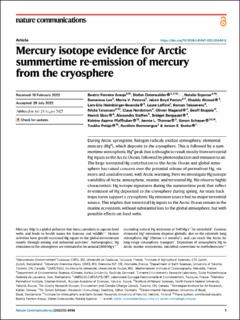| dc.contributor.author | Araujo, Beatriz Ferreira | |
| dc.contributor.author | Osterwalder, Stefan | |
| dc.contributor.author | Szponar, Natalie | |
| dc.contributor.author | Lee, Domenica | |
| dc.contributor.author | Petrova, Mariia V. | |
| dc.contributor.author | Pernov, Jakob Boyd | |
| dc.contributor.author | Ahmed, Shaddy | |
| dc.contributor.author | Heimbürger-Boavida, Lars-Eric | |
| dc.contributor.author | Laffont, Laure | |
| dc.contributor.author | Teisserenc, Roman | |
| dc.contributor.author | Tananaev, Nikita | |
| dc.contributor.author | Nordstrom, Claus | |
| dc.contributor.author | Magand, Olivier | |
| dc.contributor.author | Stupple, Geoff | |
| dc.contributor.author | Skov, Henrik | |
| dc.contributor.author | Steffen, Alexandra | |
| dc.contributor.author | Bergquist, Bridget | |
| dc.contributor.author | Pfaffhuber, Katrine Aspmo | |
| dc.contributor.author | Thomas, Jennie L. | |
| dc.contributor.author | Scheper, Simon | |
| dc.contributor.author | Petäjä, Tuukka | |
| dc.contributor.author | Dommergue, Aurélien | |
| dc.contributor.author | Sonke, Jeroen E. | |
| dc.date.accessioned | 2023-04-11T09:29:42Z | |
| dc.date.available | 2023-04-11T09:29:42Z | |
| dc.date.created | 2022-09-13T14:14:48Z | |
| dc.date.issued | 2022 | |
| dc.identifier.citation | Nature Communications. 2022, 13(1), 4956. | en_US |
| dc.identifier.issn | 2041-1723 | |
| dc.identifier.uri | https://hdl.handle.net/11250/3062318 | |
| dc.description.abstract | During Arctic springtime, halogen radicals oxidize atmospheric elemental mercury (Hg0), which deposits to the cryosphere. This is followed by a summertime atmospheric Hg0 peak that is thought to result mostly from terrestrial Hg inputs to the Arctic Ocean, followed by photoreduction and emission to air. The large terrestrial Hg contribution to the Arctic Ocean and global atmosphere has raised concern over the potential release of permafrost Hg, via rivers and coastal erosion, with Arctic warming. Here we investigate Hg isotope variability of Arctic atmospheric, marine, and terrestrial Hg. We observe highly characteristic Hg isotope signatures during the summertime peak that reflect re-emission of Hg deposited to the cryosphere during spring. Air mass back trajectories support a cryospheric Hg emission source but no major terrestrial source. This implies that terrestrial Hg inputs to the Arctic Ocean remain in the marine ecosystem, without substantial loss to the global atmosphere, but with possible effects on food webs. | en_US |
| dc.language.iso | eng | en_US |
| dc.rights | Navngivelse 4.0 Internasjonal | * |
| dc.rights.uri | http://creativecommons.org/licenses/by/4.0/deed.no | * |
| dc.title | Mercury isotope evidence for Arctic summertime re-emission of mercury from the cryosphere | en_US |
| dc.title.alternative | Mercury isotope evidence for Arctic summertime re-emission of mercury from the cryosphere | en_US |
| dc.type | Peer reviewed | en_US |
| dc.type | Journal article | en_US |
| dc.description.version | publishedVersion | en_US |
| dc.rights.holder | © The Author(s) 2022 | |
| dc.source.pagenumber | 0 | en_US |
| dc.source.volume | 13 | en_US |
| dc.source.journal | Nature Communications | en_US |
| dc.source.issue | 1 | en_US |
| dc.identifier.doi | 10.1038/s41467-022-32440-8 | |
| dc.identifier.cristin | 2051245 | |
| dc.relation.project | NILU - Norsk institutt for luftforskning: 110035 | en_US |
| dc.relation.project | EC/H2020/689443 | en_US |
| dc.relation.project | EC/H2020/730938 | en_US |
| dc.source.articlenumber | 4956 | en_US |
| cristin.ispublished | true | |
| cristin.fulltext | original | |
| cristin.qualitycode | 2 | |

